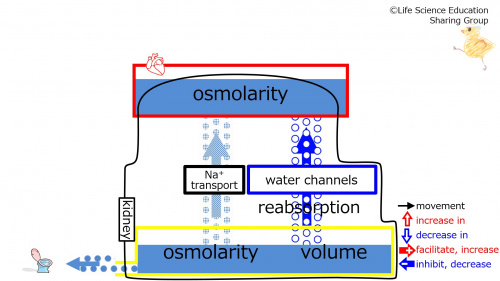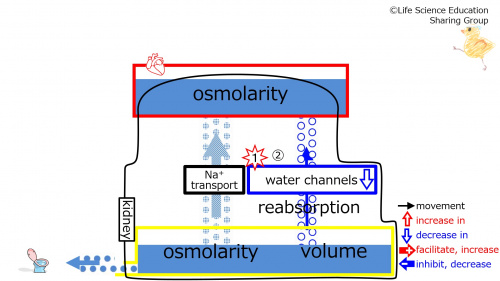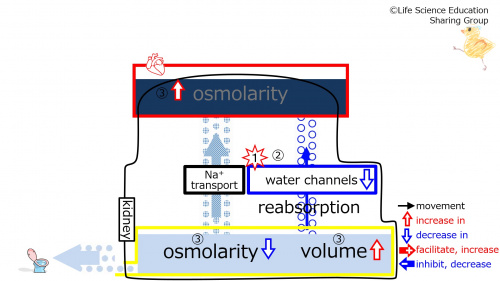「SHolroydAtWeilCornellMedQatar/Urology/Kidney/Tubules/WaterChannels/EffectOfDecrease」の版間の差分
編集の要約なし |
編集の要約なし |
||
| 18行目: | 18行目: | ||
--> | --> | ||
Step 1: Suppose that the synthesis, secretion, and blood concentration of vasopressin (ADH) decreases.<br> | Step 1: Suppose that the synthesis, secretion, and blood concentration of vasopressin (ADH) decreases.<br> | ||
Step 2: The water channel-increasing effect of vasopressin (ADH) decreases, thereby decreasing the number of water channels. This decreases the reabsorption of water | Step 2: The water channel-increasing effect of vasopressin (ADH) decreases, thereby decreasing the number of water channels. This decreases the reabsorption of water from the tubule. | ||
<br style="clear:both;" /> | <br style="clear:both;" /> | ||
| 40行目: | 40行目: | ||
//LEVEL:2 | //LEVEL:2 | ||
//RAND | //RAND | ||
With a decrease in the synthesis, secretion, and blood concentration of vasopressin (anti-diuretic hormone, ADH), water reabsorption | With a decrease in the synthesis, secretion, and blood concentration of vasopressin (anti-diuretic hormone, ADH), water reabsorption from the tubule {increases~=decreases}. | ||
//LEVEL:3 | //LEVEL:3 | ||
2020年3月3日 (火) 17:33時点における版
| With the decrease in the synthesis, secretion, and blood concentration of vasopressin (anti-diuretic hormone, ADH), the number of water channels decreases . |
Prior to vasopressin (ADH) decreasing (at baseline), we will make the assumption that the subject is in homeostasis with normal plasma and urine osmolarities (isotonic) and volumes.
Step 1: Suppose that the synthesis, secretion, and blood concentration of vasopressin (ADH) decreases.
Step 2: The water channel-increasing effect of vasopressin (ADH) decreases, thereby decreasing the number of water channels. This decreases the reabsorption of water from the tubule.
Step 3: The ratio of Na+ to water entering the plasma due to reabsorption increases. This increases plasma osmolarity (hypertonic). Because a higher ratio of Na+ to water leaves the tubule due to reabsorption, the fluid remaining in the tubule has a lower osmolarity (hypotonic). Also, with a decrease in water reabsorption, there is more water remaining in the tubule. Overall, the urine becomes less concentrated (hypotonic) and higher in volume.
Challenge Quiz
With a decrease in the synthesis, secretion, and blood concentration of vasopressin (anti-diuretic hormone, ADH), the number of water channels in the kidney increases decreases .
With a decrease in the synthesis, secretion, and blood concentration of vasopressin (anti-diuretic hormone, ADH), water reabsorption from the tubule increases decreases .
With a decrease in the synthesis, secretion, and blood concentration of vasopressin (anti-diuretic hormone, ADH), urine volume increases decreases .
With a decrease in the synthesis, secretion, and blood concentration of vasopressin (anti-diuretic hormone, ADH), urine osmolarity increases decreases .
With a decrease in the synthesis, secretion, and blood concentration of vasopressin (anti-diuretic hormone, ADH), plasma osmolarity increases decreases .
The effect of decreasing in vasopressin (anti-diuretic hormone, ADH) is to contract female genital smooth muscle increase plasma osmolarity .
The effect of decreasing in vasopressin (anti-diuretic hormone, ADH) is to increase decrease the plasma osmolarity .



